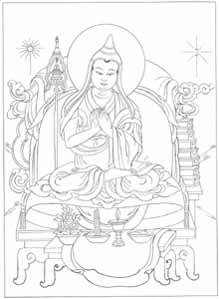Gyalse Shenpen Thaye: Difference between revisions
Bj Lhundrup (talk | contribs) |
Bj Lhundrup (talk | contribs) |
||
| Line 54: | Line 54: | ||
===External Links=== | ===External Links=== | ||
*[http://www.tbrc.org | *[http://www.tbrc.org/kb/tbrc-detail.xq;jsessionid=B02ECF9C8C4D9437E1510CF11A9E224D?RID=P697&wylie=n TBRC link here] | ||
*[http://www.lotsawahouse.org/id74.html The Gentle Rain of Benefit and Joy: An Explanation of the Practice of Sang Offering] | *[http://www.lotsawahouse.org/id74.html The Gentle Rain of Benefit and Joy: An Explanation of the Practice of Sang Offering] | ||
Revision as of 02:25, 1 November 2008
Recognized as a tulku of Minling Terchen, Gyalse Shenpen Thaye, the first Kushok Gemong Rinpoche, received teachings from the fourth Dzogchen Rinpoche, Dodrupchen, Jigme Gyalwe Nyuku, Dola Jigme Kalzang and others. After Dzogchen Monastery suffered catastrophic destruction in an earthquake, the first Kushok Gemong Rinpoche helped rebuild the monastery.
Gyalse Shenpen Thaye was a principal in the establishment of the Shri Singha monastic university at Dzogchen. According to the histories, the first Kushok Gemong Rinpoche intended to establish a great monastic university and traveled through Tibet looking for an appropriate location. While in the Dzogchen region, he passed an Indian yogi sitting on a rock, who was no longer to be found when he later returned to that rock. Gemong Rinpoche then realized that the appearance of the yogi had been a sign from the great Vidyadhara Shri Singha as to an auspicious location for the shedra. Therefore, he named the monastic college after Shri Singha.
The above was not the only auspicious incident surrounding the academy. The histories also record that when the first Kushok Gemong Rinpoche was considering which master to invite to give the blessings at the groundbreaking ceremony of Shri Singha, a great yogi of the time, Do Khyentse Yeshe Dorje, appeared suddenly and blessed a spot with his dagger. The institution was built on that spot, which is on the left-hand side of the valley of Dzogchen Monastery.
The Shri Singha shedra was became one of the leading Nyingma educational institutions and served as a model for many other Nyingma monasteries.
One of the greatest Nyingma monastic reformers of the nineteenth century, he established vinaya, monastic discipline, as a daily discipline and incorporated the Yarne retreats (rainy season) into the program of the monastery.
Gyalse Shenpen Thaye created a collection of the kama teachings of the Nyingma tradition at the request of Sangye Kunga, the seventh throne-holder of Mindroling, and Paltrul Pema Wangyal. He went on to initiate the practices of the thirteen kama sadhanas in monastic assemblies in Dzogchen Monastery, a tradition that was taken up by many other monasteries in the area. Dzogchen Monastery still continues this tradition of kama lineage practices of tantric mandalas.
His students included Khenchen Pema Dorje, Paltrul Rinpoche, and Do Khyentse.
Members of the Kushok Gemong Rinpoche line from that time became the third of the three Abbots of Dzogchen Monastery, sharing responsibility for administering Dzogchen, and particularly taking responsibility for the Shri Singha monastic university. Under the guidance of the Gemong Rinpoches, Shri Singha monastic university grew into one of the most prestigious academies in Tibet.
Literary Works
Main Teachers
- Dodrupchen Jigme Trinley Ozer
- Jigme Gyalwe Nyugu
- Dola Jigme Kalzang
- 4th Dzogchen Rinpoche
- Sengtruk Pema Tashi
Main Students
Main Lineages
- [[
Alternate Names & Spellings
- Kushok Gemong Rinpoche
- Gemang Rinpoche
- Zhenphen Thaye Ozer (gzhan phan mtha' yas 'od zer)
- Dzogchen Gyalse Zhenphen Thaye (rdzogs chen rgyal sras gzhan phan mtha' yas)
- Getse Zhenphen Thaye (dge rtse gzhan phan mtha' yas)
- Gemang Gyalse Zhenphen Thaye (dge mang rgyal sras gzhan phan mtha' yas)
- Dzogchen Khenrab Zhenphen Thaye (rdzogs chen mkhan rabs gzhan phan mtha' yas)
Other Reference Sources
- [[
